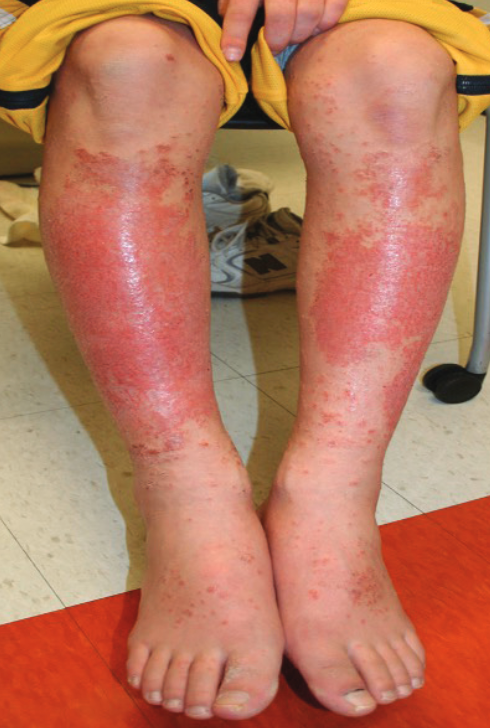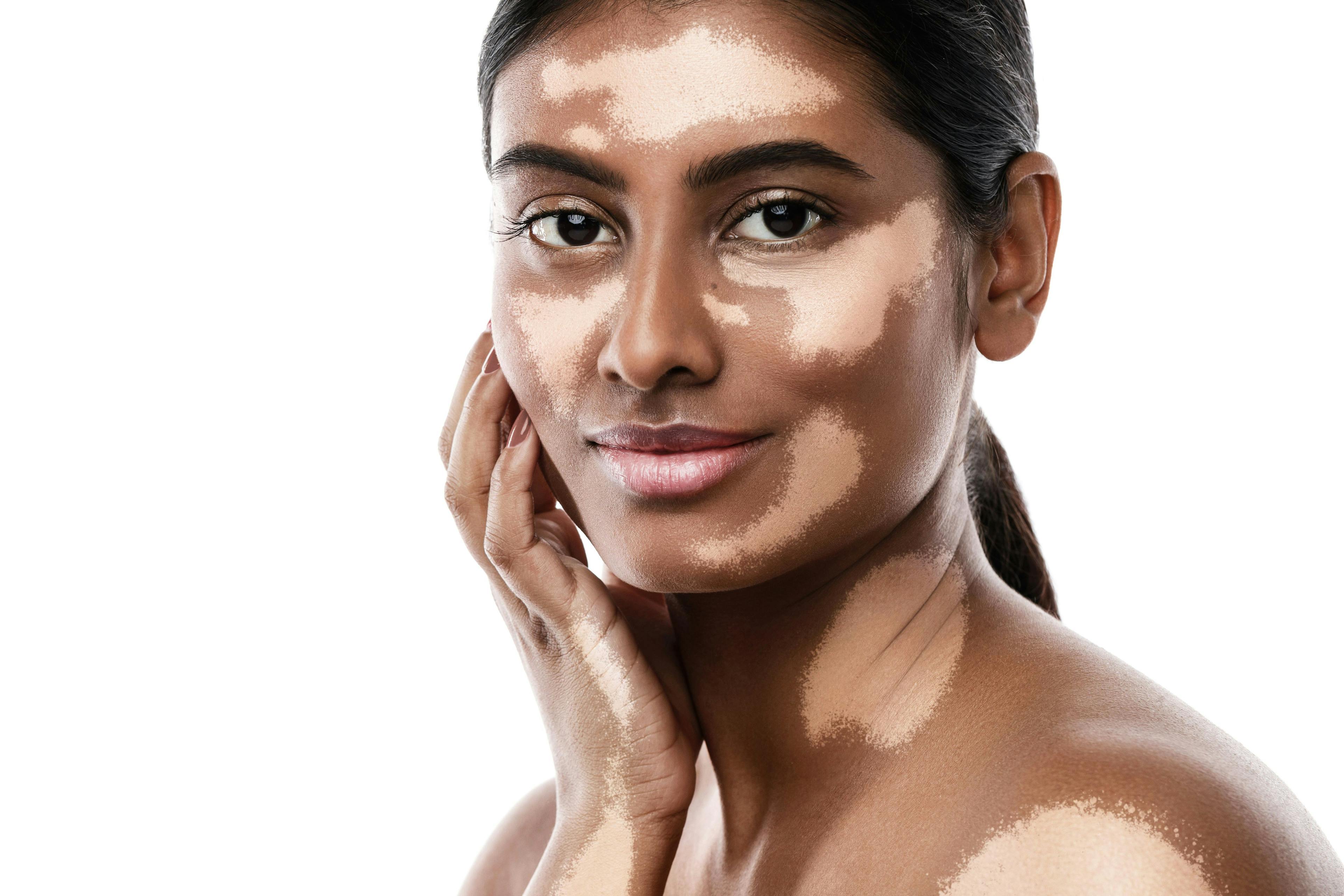- Acne
- Actinic Keratosis
- Aesthetics
- Alopecia
- Atopic Dermatitis
- Buy-and-Bill
- COVID-19
- Case-Based Roundtable
- Chronic Hand Eczema
- Drug Watch
- Eczema
- General Dermatology
- Hidradenitis Suppurativa
- Melasma
- NP and PA
- Pediatric Dermatology
- Pigmentary Disorders
- Practice Management
- Precision Medicine and Biologics
- Prurigo Nodularis
- Psoriasis
- Psoriatic Arthritis
- Rare Disease
- Rosacea
- Skin Cancer
- Vitiligo
- Wound Care
Publication
Article
Dermatology Times
Talking to Children and Adolescents About Vitiligo
Author(s):
Frank discussions about managing the disorder can boost patients’ self-esteem and quality of life.
Although most skin conditions are not life-threatening, they can negatively affect quality of life. It is important for children and adolescents to fit in with their peers and not feel that they are different. Dermatologists need to think a bit differently when dealing with patients with vitiligo, a loss of skin color which occurs when pigment-producing cells in the body die or stop functioning. A productive patient-clinician relationship for this disorder starts with the first encounter.
The First Visit
When greeting a child or adolescent for the first time, Angela S. Casey, MD, of the Center for Surgical Dermatology & Dermatology Associates in Westerville, Ohio, always looks them in the eye, introduces herself, and extends her hand for them to shake.
“I tell them, ‘I am so glad that you’re here today, and I look forward to talking with you and seeing how I can help,’” she said. She follows that up with questions about themselves, such as “What grade are you in?” or “How’s your summer going?” and asks them about their interests and hobbies.
“I also tell them, ‘We’re just going to talk today’ to reassure them that there are no needles or procedures involved at this visit. It never ceases to amaze me how much anxiety young people can have about going to the doctor because they don’t know what to expect,” Casey said. “I find that the approach of getting to know them and being clear about what will happen at the visit alleviates much of their stress. It also empowers them with the courage to be honest and communicates that our team is interested in them as an individual and not just focused on the problem at hand.”
When Aaron M. Secrest, MD, PhD, MBA, vice chair of business strategy and assistant professor in the Department of Dermatology and Population Health Sciences at the University of Utah in Salt Lake City, completed his intern year in pediatrics at Cincinnati Children’s Hospital Medical Center in Ohio, he learned how essential it is to talk to both the patient and the parents.
He begins each visit introducing himself and uses his first name to better connect. He then asks a few questions about their life to establish a report. “My patient is the child or teen, so I spend as much of the visit talking to them,” he said. “The parents can listen and hear the same thing, but talking to the patient helps me ensure I’m not talking over their heads.”
Cory Gaskins, MD, resident medical expert at BestBotox.ca, a resource for patients looking for physicians who specialize in Botox, noted when meeting with a child or adolescent who has vitiligo, it is important to let them warm up to you. “A comfortable environment is key for communication,” he said. “Make sure to communicate on their level, using terms they understand. It is also important to be respectful and understanding of their feelings.”
Key Questions
An important question at the beginning is, “What brings you in today?” For a child or adolescent with vitiligo, follow-up questions should typically focus on when they first noticed the conditions; what treatments, if any, have been tried; and the results of such treatment.
After this, Casey will delve into the rest of their medical history, including other medical conditions, medications, and family history. “I also ask if they have seen anything online or on social media about vitiligo,” she said. “This gives them an opportunity to open up and gives me a glimpse into how they might be feeling about their condition. It is also a chance to dispel some of the myths that might be floating around.”
It’s also important to understand patients’ level of adherence and any potential barriers to treatment—such as cost, support for consistency with prescribed treatment, and ability to get to appointments. “Taking a step back and looking at the entirety of the situation sets us up for success in executing their treatment plan,” Casey said.
At Secrest’s clinic, he gives every patient the Skindex-16 assessment, 16 quick questions answered online and used as validated measures of the effects of skin disease on quality of life.1 This covers questions about their symptoms, their physical functioning, and how their skin issue affects their mood. It shows Secrest the emotional effects the skin issue has on the patient so that he can directly say something such as, “It appears this is really bothering you.”
“I find that it helps to focus the visit, and my teen patients are much more straightforward answering questions on an iPad or on their phone than in person to me face-to-face,” he said.
Other Skin Conditions
For patients with acne and atopic dermatitis, things can be a little bit different. “If the patient is picking their acne or scratching their eczema, I don’t ask if they are [bothered by their condition]. I know the answer, they know the answer,” Secrest said. “I just make statements of fact. ‘It looks like you pick at this’ or ‘This looks very itchy; I see the scratches.’ If they are embarrassed, I show them my cuticles and let them know that picking at things is very common and people do it when they’re stressed subconsciously.”
Many of the same quality-of-life questions apply to acne and atopic dermatitis, though because they are more common, many children and adolescents are more familiar with them and don’t often has as much anxiety as patients with vitiligo. “I might ask if they have siblings or friends who have had similar conditions to get a read on their understanding and how they perceive it,” Casey said. “The questions about online and social media are equally important as there are all sorts of acne and eczema treatment ‘hacks’ out there; their appointment is an opportunity to address these.”
Psychosocial Concerns
Asking the patient about how they’re feeling about their condition and if it’s bothering them is important in getting a read on how they are adjusting to their issue. “Just a simple statement like that is validating and usually gets the patient to open up,” Casey said. “I know that kids and teens go through so much, but you can’t get insight if you don’t ask.”
Casey will try to get feedback about peer relationships and how these have influenced their feelings about their condition. “I find that the best approach is a direct and honest conversation to build trust and encourage open communication,” she said. “I direct them to support groups or communities online, such as The Vitiligo Society, which can be very helpful in reassuring them that they are not alone in their feelings and concerns.”
Fortunately, there are many positive role models today, such as Winnie Harlow, a Canadian fashion model with vitiligo, who serve as a good example that skin does not define a person. Casey noted that individuals such as Harlow are revered for their beauty and share the message that “we are all unique individuals, and sometimes those characteristics that make us different are exactly what make us exceptional.”
Building a Solid Relationship
Establishing trust in the first visit will help keep a relationship strong throughout the course of the treatment. Casey assures her patients that she is there to help and will do everything that she can to improve the condition. She makes patients a promise that her team will take the very best care of them and be there to support them on their journey, and though there may be some bumps along the way, they are in this together.
One of Casey’s patients was a 12-year-old girl who had generalized vitiligo. The condition started with affected areas on her hands, but she didn’t come in for treatment until the vitiligo had spread to her face. “Her mother shared with me the difficulty that she experienced because the boys at school were starting to tease her, and one of the girls in her class had started a rumor that other students could ‘catch’ this skin disease if they came in contact with her,” Casey said. “Middle school is difficult enough without having this additional stress added into the mix.”
When Casey first met with her, the patient couldn’t make eye contact with her, and despite encouragement from her mom, the girl had a hard time expressing how she felt because she was shy and embarrassed. “I calmly talked with her about her diagnosis, some of the treatment options, timeline, and expectations,” Casey said. “We started her on topical treatment, but it was many months before we started to see any improvement. And even with the improvement, we still didn’t clear all of her vitiligo. However, the most impactful parts of her treatment were the conversations that we had along the way, about how she was feeling about her condition, any frustrations or fears she had about whether the treatment will work, and ways that we could help her feel better and boost her confidence.”
Casey also took the opportunity to educate the girl’s classmates about vitiligo through several school emails and informational messages that went out to parents and students in her class, which created a better environment for the patient. “Being open about the fact that sometimes treatments don’t work is important so that we can set realistic expectations,” she said. “Additionally, being as clear as we can on timelines is key: letting a patient know that a particular treatment will likely take months before we see an improvement helps manage their expectations and creates a sense of security.”
Reference:
- Chren, MM. The Skindex instruments to measure the effects of skin disease on quality of life. Dermatol Clin. 2012;30(2):231-236. doi:10.1016/j.det.2011.11.003

Newsletter
Like what you’re reading? Subscribe to Dermatology Times for weekly updates on therapies, innovations, and real-world practice tips.


























